How to play OGM files
An OGM file is an OGG media file. OGM is a container format that can store video streams, audio streams and subtitles. This article shows how to play OGM files and use some of its advantages over the AVI container. It details the easiest method as well as showing to get OGM files working on general players like Windows Media Player.
What is OGM? What do I need to play it?
OGM is a container format that can store video, audio and subtitle streams, but also supports multiple subtitle tracks, multiple audio of differing formats, support for chapters and Vorbis audio. To play these files you need three things; Haali Media Splitter (or OggDS or similar), decoders for the video and audio streams included and a software player. But before we get into installing all of that, I just want to mention the VLC player and how it can make this much easier.
The Easiest Method
 Download and install the VLC player. The VLC package already includes software to play OGM files as well as the video and audio content (usually) and can use some of its extra features.
Download and install the VLC player. The VLC package already includes software to play OGM files as well as the video and audio content (usually) and can use some of its extra features.
You can get VLC for Windows from this URL.
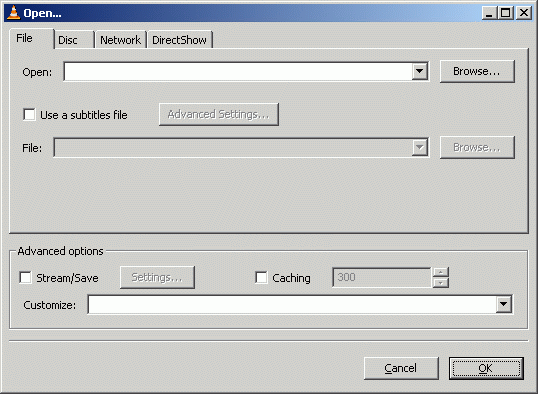 Click File and click the Open File option.
Click File and click the Open File option.Now, click the Browse button next to the first white line at the top of the window with title "Open.." and navigate through your hard drive for the video you wish to watch and select it. After you have selected the video, click OK and VLC will start playing the video you chose.
For other Operating Systems...
Mac: http://www.afterdawn.com/software/alternative_platforms/mac_software/vlc_for_mac.cfm
Linux: http://www.afterdawn.com/software/video_software/video_players/vlc_linux.cfm
Using subtitles and multiple audio with VLC
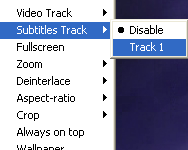 When playing an OGM file in VLC, right click on the video and see if you can skip between chapters (next, previous etc). You will also see that you can easily change the subtitles while the file keeps playing, or the audio track or any number of things. VLC's support for OGM makes it possibly the best solution for a new user.
When playing an OGM file in VLC, right click on the video and see if you can skip between chapters (next, previous etc). You will also see that you can easily change the subtitles while the file keeps playing, or the audio track or any number of things. VLC's support for OGM makes it possibly the best solution for a new user.Recommended Solution
This is a bit more of a manual method but is beneficial to know about and will add support for OGM files to Windows Media Player and other software. Firstly, you need to install the Haali Media Splitter, this is additional software that will automatically run when Windows Media Player or likewise encounters an OGM file.
Install Haali Media Splitter
Step 1. Download Haali Media Splitter by clicking here.
 Step 2. Run the Haali Media Splitter installer. The first thing you will need to do is accept the license agreement of the software. Click I Agree, and you will be asked to select a destination folder. The default is fine so click Next and you will be asked to specify a Start Menu folder, again, the default is fine so click Next. Now you have come to the options (as the picture shows).
Step 2. Run the Haali Media Splitter installer. The first thing you will need to do is accept the license agreement of the software. Click I Agree, and you will be asked to select a destination folder. The default is fine so click Next and you will be asked to specify a Start Menu folder, again, the default is fine so click Next. Now you have come to the options (as the picture shows).
Make sure that the Enable OGG/OGM support option is selected and click Install. It should only take a few seconds before it is complete. Now, Windows Media Player has the ability to open OGM files, now we need to provide support for the video and audio information in the files to ensure playback.
Install and configure FFDShow
Step 1. The obvious and vital first step is to download FFDShow by clicking here.
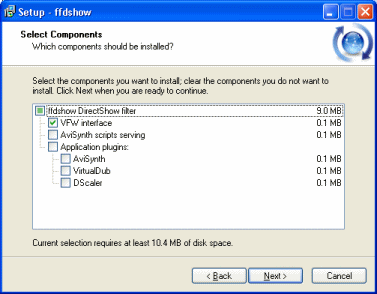 Step 2. Now you have to install FFDShow on your Windows operating system (the OS used in this example is XP Pro). Run the installer. Select your language and click Next. Now you must accept the license agreement of FFDShow; select "I accept the agreement" and click Next. Now you can choose an install directory (default is fine) and click Next again. You are now on the Select Components screen; "VfW Interface" should be selected by default, but if it is not, then please select it as shown.
Step 2. Now you have to install FFDShow on your Windows operating system (the OS used in this example is XP Pro). Run the installer. Select your language and click Next. Now you must accept the license agreement of FFDShow; select "I accept the agreement" and click Next. Now you can choose an install directory (default is fine) and click Next again. You are now on the Select Components screen; "VfW Interface" should be selected by default, but if it is not, then please select it as shown.
Click Next and select a start menu folder (default is perfectly fine again), Click Next again and now you reach the "Select Additional Tasks" screen.
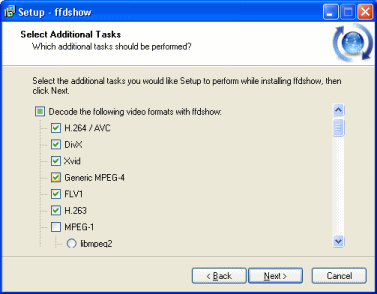 It is important now that you ensure that under "Decode the following video formats with ffdshow", H.264 / AVC, DivX, and XviD options are selected. Scroll down further until you reach "Decode the following audio formats with ffdshow" and just ensure that MP3, AC3 and Vorbis are selected. When you click Next, you will come to a "Management of compatibility issues" screen.
It is important now that you ensure that under "Decode the following video formats with ffdshow", H.264 / AVC, DivX, and XviD options are selected. Scroll down further until you reach "Decode the following audio formats with ffdshow" and just ensure that MP3, AC3 and Vorbis are selected. When you click Next, you will come to a "Management of compatibility issues" screen.
It is recommended to leave the option to use FFDShow for video only with the programs listed beneath to prevent any compatibility problems with other software. Media Player Classic and Windows Media Player will be in here. Click Next and you will get the same screen again, this time for audio. Click Next and select your speaker setup (if you only have 2 speakers, its stereo). Click Next again and then "Install".
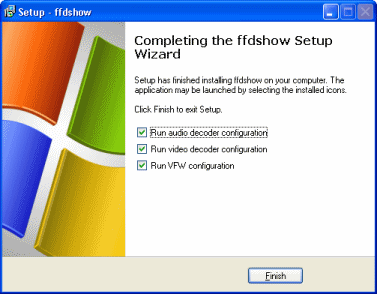 When the installation is finished, your playback software will now be able to decode video and audio stored within OGM files. Try playing them now in Windows Media Player. To play with Windows Media Player, right click the OGM file and go to "Open With" and then the "Choose Program" option. From the list, select Windows Media Player.
When the installation is finished, your playback software will now be able to decode video and audio stored within OGM files. Try playing them now in Windows Media Player. To play with Windows Media Player, right click the OGM file and go to "Open With" and then the "Choose Program" option. From the list, select Windows Media Player.
If you get a message alerting you that the extension is not recognized by Windows Media Player, select "Don't ask me again" and click Yes.
Subtitles and multiple audio with Windows Media Player
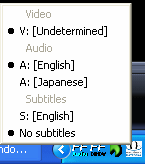 Look at the systray on your desktop (the area usually in the lower right hand corner that has the small icons) while the video is playing and looking for the Haali Media Splitter icon hover the mouse over each icon until you find it). Now, Simply right-clicking the icon will bring up a menu allowing you to change the Subtitles ("S") and audio ("A"). See the picture for an example.
Look at the systray on your desktop (the area usually in the lower right hand corner that has the small icons) while the video is playing and looking for the Haali Media Splitter icon hover the mouse over each icon until you find it). Now, Simply right-clicking the icon will bring up a menu allowing you to change the Subtitles ("S") and audio ("A"). See the picture for an example.
If you want to associate OGM files with Windows Media Player (will automatically launch the player when you open the file), you can do so by going to your Control Panel --> Folder Options. Click the File Types tab and let the list load. Scroll down to OGM, select it and you will see you have the ability to change what program it is associated with. Change it to WMP or whatever you want and click Apply.
Another option
After you have installed the Haali Media Splitter you can hunt down individual decoders and install them if you want. Some users promote the use of codec packs. Codec packs are big collections of video codecs. At first sight they can appear very useful, as they will install enough codecs to decode just about any video files you can get online. However, they have also been known to cause problems with playback too.
Still though, if you prefer to install a codec pack instead of using FFDShow, then here are some of your options.
K-Lite Codec Pack [full]
XP Codec Pack
Cole2k Media Codec Pack Advanced
X Codec Pack
Troubleshooting and useful links
If you want to dive into the world of digital video, but want to first learn even the most common lingo, here are some good links for you:
· Glossary definition for OGM
· What is a codec?
· What does "encoding" mean?
· AfterDawn.com: Video term glossary
· AfterDawn Forums: Playback problems
Additionally, if you prefer to use a solution where you use a separate video player software and a separate set of codecs, you might want to try out different video players as well. We have a good selection of freeware players available on our site, but here are some of our favorite ones:
Media Player Classic
Zoom Player
It should be noted that sometimes, despite all the efforts, analysis and trial&error you've applied in order to get a video to play, it just wont. Quite often in those cases, even when none of the file analytics programs (such as AVIcodec or VideoInspector) seem to help, you can come to a conclusion that the file is corrupted. If that is the case, you're pretty much out of luck and might want to try to re-download the file in order to see whether the problem was with the download process itself.
Version History
v1.0 - 23rd of March, 2007 by Dela
Written by: James Delahunty

